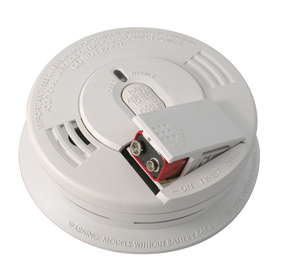HOW DO IONIZATION SMOKE DETECTORS WORK?

All smoke detectors consist of two basic parts: a sensor to sense the smoke and a very loud electronic horn to wake people up. Smoke detectors can run off of a 9-volt battery or 120-volt house current.
Ionization smoke detectors use an ionization chamber and a source of ionizing radiation to detect smoke. This type of smoke detector is more common because it is inexpensive and better at detecting the smaller amounts of smoke produced by flaming fires.
Inside an ionization detector is a small amount (perhaps 1/5000th of a gram) of americium-241. The radioactive element americium has a half-life of 432 years, and is a good source of alpha particles.
Another way to talk about the amount of americium in the detector is to say that a typical detector contains 0.9 microcurie of americium-241. A curie is a unit of measure for nuclear material. If you are holding a curie of something in your hand, you are holding an amount of material that undergoes 37,000,000,000 nuclear transformations per second. Generally, that means that 37 billion atoms in the sample are decaying and emitting a particle of nuclear radiation (such as an alpha particle) per second. One gram of of the element radium generates approximately 1 curie of activity (Marie Curie, the woman after whom the curie is named, did much of her research using radium).
An ionization chamber is very simple. It consists of two plates with a voltage across them, along with a radioactive source of ionizing radiation, like this:
The alpha particles generated by the americium have the following property: They ionize the oxygen and nitrogen atoms of the air in the chamber. To "ionize" means to "knock an electron off of." When you knock an electron off of an atom, you end up with a free electron (with a negative charge) and an atom missing one electron (with a positive charge). The negative electron is attracted to the plate with a positive voltage, and the positive atom is attracted to the plate with a negative voltage (opposites attract, just like with magnets). The electronics in the smoke detector sense the small amount of electrical current that these electrons and ions moving toward the plates represent.
When smoke enters the ionization chamber, it disrupts this current -- the smoke particles attach to the ions and neutralize them. The smoke detector senses the drop in current between the plates and sets off the horn.
Speaking of alarms, whenever the words "nuclear radiation" are used an alarm goes off in many people's minds. The amount of radiation in a smoke detector is extremely small. It is also predominantly alpha radiation. Alpha radiation cannot penetrate a sheet of paper, and it is blocked by several centimeters of air. The americium in the smoke detector could only pose a danger if you were to inhale it. Therefore, you do not want to be playing with the americium in a smoke detector, poking at it, or disturbing it in any way, because you don't want it to become airborne.
Ionization smoke detectors use an ionization chamber and a source of ionizing radiation to detect smoke. This type of smoke detector is more common because it is inexpensive and better at detecting the smaller amounts of smoke produced by flaming fires.
Inside an ionization detector is a small amount (perhaps 1/5000th of a gram) of americium-241. The radioactive element americium has a half-life of 432 years, and is a good source of alpha particles.
Another way to talk about the amount of americium in the detector is to say that a typical detector contains 0.9 microcurie of americium-241. A curie is a unit of measure for nuclear material. If you are holding a curie of something in your hand, you are holding an amount of material that undergoes 37,000,000,000 nuclear transformations per second. Generally, that means that 37 billion atoms in the sample are decaying and emitting a particle of nuclear radiation (such as an alpha particle) per second. One gram of of the element radium generates approximately 1 curie of activity (Marie Curie, the woman after whom the curie is named, did much of her research using radium).
An ionization chamber is very simple. It consists of two plates with a voltage across them, along with a radioactive source of ionizing radiation, like this:
The alpha particles generated by the americium have the following property: They ionize the oxygen and nitrogen atoms of the air in the chamber. To "ionize" means to "knock an electron off of." When you knock an electron off of an atom, you end up with a free electron (with a negative charge) and an atom missing one electron (with a positive charge). The negative electron is attracted to the plate with a positive voltage, and the positive atom is attracted to the plate with a negative voltage (opposites attract, just like with magnets). The electronics in the smoke detector sense the small amount of electrical current that these electrons and ions moving toward the plates represent.
When smoke enters the ionization chamber, it disrupts this current -- the smoke particles attach to the ions and neutralize them. The smoke detector senses the drop in current between the plates and sets off the horn.
Speaking of alarms, whenever the words "nuclear radiation" are used an alarm goes off in many people's minds. The amount of radiation in a smoke detector is extremely small. It is also predominantly alpha radiation. Alpha radiation cannot penetrate a sheet of paper, and it is blocked by several centimeters of air. The americium in the smoke detector could only pose a danger if you were to inhale it. Therefore, you do not want to be playing with the americium in a smoke detector, poking at it, or disturbing it in any way, because you don't want it to become airborne.

